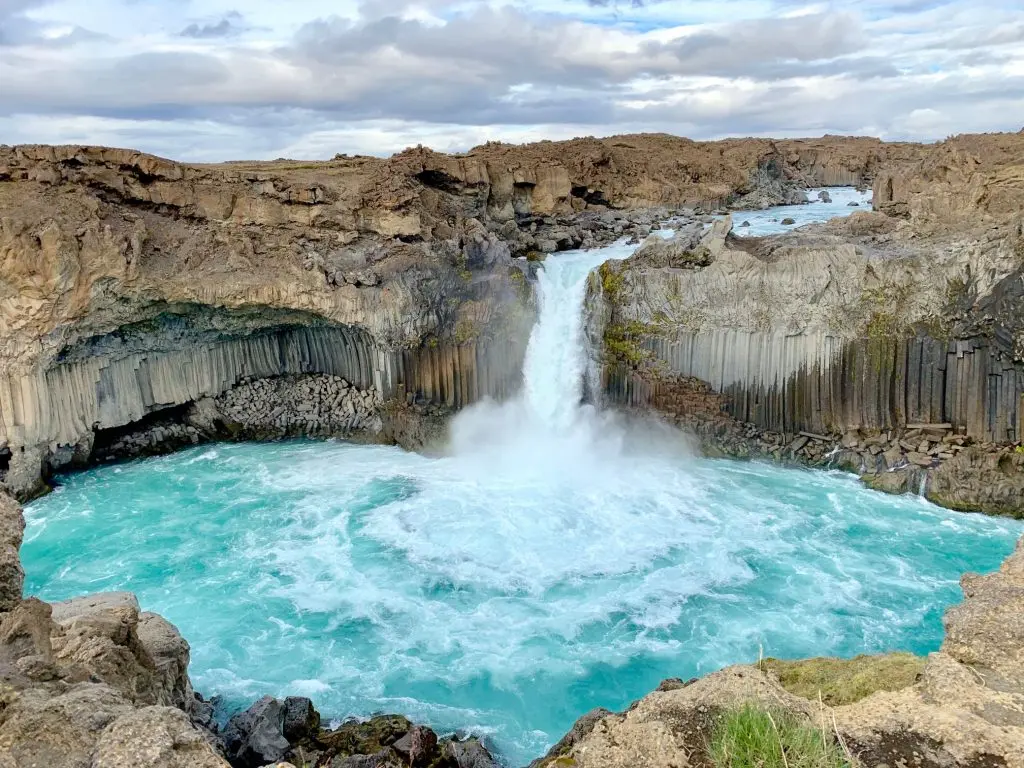Iceland is a land of breathtaking natural wonders, and its waterfalls are among the most spectacular sights you’ll ever witness. From towering cascades plunging into rugged canyons to serene falls hidden in lush landscapes, each one offers a unique experience.
Introduction
Imagine standing before a roaring cascade, mist cooling your face as powerful torrents crash into the rocks below. Iceland, the land of fire and ice, is home to some of the most stunning waterfalls in the world. Whether you’re a nature lover, photographer, or adventure seeker, the best waterfalls in Iceland offer awe-inspiring beauty at every turn. From towering giants to hidden gems, these waterfalls showcase the raw power and serene elegance of Iceland’s natural landscapes. If you’re planning a trip to this breathtaking country, make sure to add these Iceland waterfalls to your must-visit list.

Table of Contents
The Top 10 Icelandic Waterfalls
1. Gullfoss
One of the best waterfalls in Iceland, Gullfoss is a breathtaking two-tiered cascade that plunges dramatically into the Hvítá River canyon. Located along the popular Golden Circle route, Gullfoss is easily accessible and attracts thousands of visitors each year.
- Height: 32 meters (105 feet)
- Why Visit?: The sheer power and golden mist create an unforgettable sight.
- Best Time to Visit: Year-round, but winter offers a magical frozen landscape.
2. Seljalandsfoss
One of the most unique Iceland waterfalls, Seljalandsfoss allows visitors to walk behind the cascading water for an extraordinary view. The waterfall drops from 60 meters (197 feet), creating a picture-perfect scene.

- Why Visit?: Walk behind the waterfall and feel the refreshing mist.
- Best Time to Visit: Summer, when the path behind the waterfall is safe to walk on.
- Pro Tip: Wear waterproof clothing—the mist will soak you!
3. Skógafoss
Towering at 60 meters (197 feet), Skógafoss is one of the best waterfalls in Iceland and among the most photographed. The waterfall’s heavy mist often creates stunning rainbows, making it a favorite among photographers and nature lovers.

- Why Visit?: Climb the staircase beside the waterfall for a panoramic view.
- Best Time to Visit: Year-round, but summer offers lush greenery surrounding the falls.
- Fun Fact: Legend has it that a Viking treasure chest is hidden behind the waterfall!
4. Dettifoss
Known as the most powerful waterfall in Europe, Dettifoss is an awe-inspiring sight. Located in North Iceland’s Vatnajökull National Park, this waterfall is truly a force of nature.

- Height: 44 meters (144 feet)
- Why Visit?: Feel the ground tremble under the waterfall’s sheer power.
- Best Time to Visit: Summer, as winter roads may be inaccessible.
- How to Get There: Access via Route 864 or 862 (4×4 recommended in winter).
5. Goðafoss
Goðafoss, meaning “Waterfall of the Gods,” has a captivating history. Legend says that when Iceland converted to Christianity, pagan idols were thrown into the falls.

- Height: 12 meters (39 feet)
- Why Visit?: The semi-circular shape creates a stunning, wide cascade.
- Best Time to Visit: Spring and summer for lush surroundings; winter for an icy wonderland.
- Pro Tip: Visit at sunrise or sunset for breathtaking colors in the sky.
6. Háifoss
At 122 meters (400 feet), Háifoss stands as one of the best waterfalls in Iceland, offering a dramatic plunge into a deep canyon. This breathtaking cascade is located in the Highlands, requiring a bit of effort to reach.

- Why Visit?: Incredible height and stunning canyon views.
- Best Time to Visit: Summer, when roads are accessible.
- Getting There: A 4×4 vehicle is required for the rough road leading to the falls.
7. Hraunfossar
Unlike traditional waterfalls, Hraunfossar is a series of small cascades flowing out of a lava field. The water appears to emerge magically from the rocks, creating a mystical scene.

- Why Visit?: Unique lava-filtered water creates a surreal landscape.
- Best Time to Visit: Autumn, when surrounding foliage turns vibrant shades of red and yellow.
- Nearby Attraction: Barnafoss, another powerful waterfall just a short walk away.
8. Svartifoss
Located in Skaftafell National Park, Svartifoss is famous for its striking black basalt columns framing the waterfall. These hexagonal rock formations inspired Reykjavik’s Hallgrímskirkja Church.

- Why Visit?: One of Iceland’s most unique geological formations.
- Best Time to Visit: Summer, when hiking trails are clear.
- Hiking Difficulty: Moderate, about 1.5 km (1 mile) from the visitor center.
9. Aldeyjarfoss
Tucked away in North Iceland, Aldeyjarfoss features stunning basalt rock formations and turquoise waters, making it a hidden treasure worth seeking out.

- Why Visit?: Dramatic contrast between dark basalt columns and vibrant blue water.
- Best Time to Visit: Summer, as winter access can be challenging.
- How to Get There: A 4×4 is recommended for the highland roads leading to the falls.
10. Dynjandi
Nestled in the remote Westfjords, Dynjandi is often called “the jewel of the Westfjords.” This multi-tiered waterfall resembles a bridal veil and cascades down like a staircase.

- Height: 100 meters (328 feet)
- Why Visit?: Breathtaking multi-layered waterfall with peaceful surroundings.
- Best Time to Visit: Summer, as the Westfjords can be challenging to access in winter.
- Pro Tip: Take your time exploring the smaller waterfalls below Dynjandi.
If you’re looking for one of the best waterfalls in Iceland that offers both grandeur and serenity, Dynjandi is a must-visit. Its remote location means fewer crowds, allowing you to soak in the beauty of Iceland waterfalls in peace.
Conclusion
From the roaring power of Dettifoss to the serene beauty of Hraunfossar, the best waterfalls in Iceland showcase the country’s incredible natural wonders. Whether you’re driving the Ring Road or venturing into the Highlands, each of these Iceland waterfalls offers a unique experience.
Have you visited any of these breathtaking waterfalls? Share your favorite in the comments below! And if you’re planning your Iceland adventure, be sure to add these stunning cascades to your itinerary.

